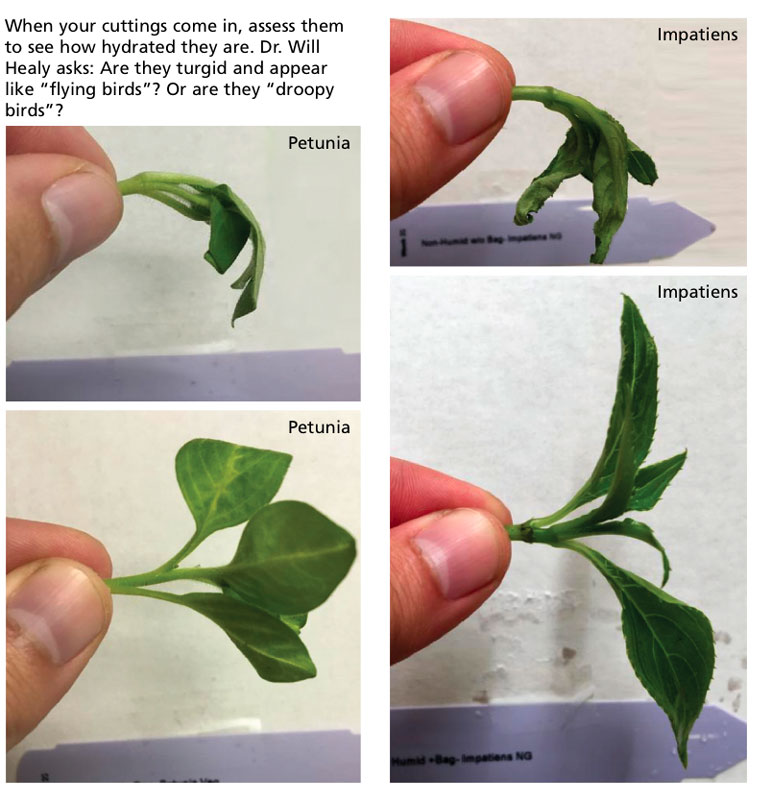2/1/2022
Stick & Die: How to Avoid It
Bill Calkins
When cuttings are harvested at farms, they’re almost always in prime condition and ready to grow into beautiful plants that wow and amaze gardeners. Then, they go into a box and onto a plane or truck for a journey over hundreds (or thousands) of miles before arriving at your greenhouse. A lot can happen in that time. When the boxes are popped open, your job begins. Sometimes, this is as simple as rehydration under mist, but other times, it can require major resuscitation.
Here’s a quick tutorial on holding and handling cuttings so when they root, you get the uniformity necessary to produce your best crops ever. Much of this information comes from a recent Tech On Demand, brought to you by GrowerTalks podcast with Dr. Will Healy, Senior Technical Manager at Ball Horticultural Company.

Assessing dehydration
New research is being conducted as we speak and the findings are clear.
“Rooting variability is directly related to sticking uniformly hydrated cuttings,” Will says. “Uniform rooting equals uniform performance and flowering.”
Unfortunately, variability does start at the farm and this is out of your control. The time of day when cuttings are harvested isn’t always constant. And this influences the hydration of the plants from the beginning. But more impactful is the dehydration that results from cooling processes, cardboard boxes that suck the moisture from cuttings and temperature bounces in shipping that can cause major issues.
“Remember, once a URC reaches 70% hydration or lower, rooting is significantly delayed,” Will says.
Here’s how to start your cuttings assessment when boxes arrive:
• Assess the box. Check all areas with an infrared thermometer (the edges, middle of the box and ice pack temperature.) This will give you a baseline from which to work.
• Assess the bag. Is there moisture or condensation? If not, the cuttings are most likely dehydrated.
• Assess the URCs themselves. Are they turgid and appear like “flying birds”? Or are they “droopy birds”?
• Assess the datalogger, if there’s one with the shipment. Temperature fluctuations greater than 20 degrees are concerning.
Once you make these assessments, you’ll know what you’re working with and can begin the process of bringing the cuttings back to correct hydration levels, so they’re uniform from day one.
Rehydration tactics
Be sure to listen to the full podcast recording because Will goes into quite a bit of detail about coolers, humidifiers and fog systems. Here are the basics, according to him:
• A “bad” approach is putting your just-received and dehydrated cuttings into a dry cooler.
• A “good” way to handle them is unpacking and laying them out in the greenhouse after wetting the floors.
• A “better” approach is putting URCs into a cooler with a humidity system.
• The “best” tactic is to hold trays in a fog area before moving them to mist benches.
Let’s talk about the best approach. When you unpack the boxes, separate your new cuttings into groups based on hydration needs to increase airflow and temperature reductions.
“Place your cuttings into a 50 to 55F (10 to 12C) chamber with fog so thick you can’t see the back of the chamber,” Will says. “Your cuttings will hydrate the fastest if you take them out of the bag. Leaving them in the bags placed loosely in a tray is far better than leaving them in the box.”
Here’s a fun fact: Sticking lines dehydrate URCs. Your facilities aren’t as humid as you’d expect, Will says. “One hour in a dry sticking area can reduce hydration to 70%.”
This is what you want to avoid at all costs. Hold the trays in a fog area until the time your team moves them to the bench and make sure the greenhouse floors are wet to ensure high relative humidity in your mist area.
Final thoughts
As mentioned before, this article only touches on the highlights of the podcast episode. You can find the full recording at GrowerTalks.com/techondemand and also on your favorite podcast app like iTunes, Spotify, Google, Stitcher and more. Just search for Tech On Demand, brought to you by GrowerTalks.
Will closed the episode with a very important reminder. “Many of our URCs are 90% water or more. We need to manage the internal moisture conditions before sticking to provide the most uniform performance possible.”
Establishing clear holding and handling protocols for your young plant team needs to be at the very top of your to-do list this year. Don’t assume everyone is on the same page, especially when new team members are being added all the time. Train and retrain because starting strong is the best way to ensure consistent and uniform production. GT